
News
By Smart Growth America, June 12, 2018
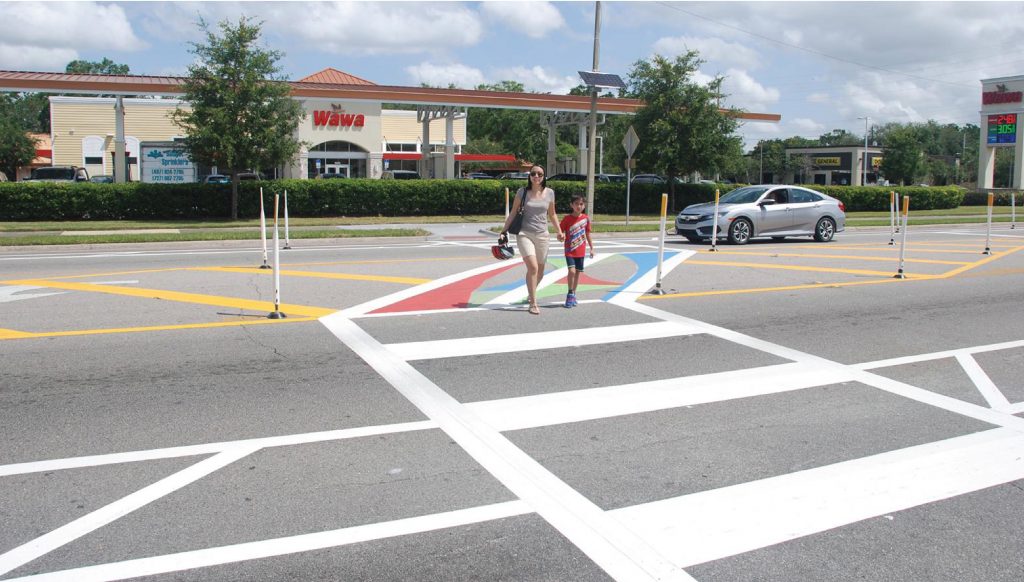
Orlando’s demonstration project on Curry Ford Road added a new mid-block crossing with a painted, protected pedestrian refuge.
The Orlando metropolitan region has long had notoriously dangerous roadways, especially for people walking. A team from the City of Orlando dedicated to improving safety launched a demonstration project on Curry Ford Road, a commercial arterial with a history of crashes involving people walking and biking that spans both the city’s and county’s jurisdictions. By collaborating with Orange County staff and with local elected officials, the team transformed this five-lane speedway into a three-lane Complete Street with protected cycle tracks and a mid-block crossing with a painted pedestrian refuge. Although local business owners and nearby residents supported the demonstration project, people who commute through the neighborhood were resistant to the changes, which raised important questions about the necessary trade-offs between safety and speed when designing safer streets for people.
Orlando has a serious traffic safety problem, especially for people walking. In NCSC’s Dangerous by Design 2016 report, the Orlando metropolitan area ranked as the third most dangerous region in the country for people walking. The city has been taking steps to address this problem, including joining the Vision Zero network and developing a Vision Zero resolution and action plan to eliminate serious injuries and fatalities on its streets. A team from Orlando also applied for the Safe Streets Academy to learn more about creative ways to make their streets safer places for people. As part of the Academy, Orlando launched a demonstration project on Curry Ford Road, a commercial street with a dangerous speeding problem and a history of crashes involving people walking and biking. Through this project, the city hoped to show the community and elected officials how important street design is to traffic safety and build better working relationships with Orange County, a vital partner in creating safer streets throughout the region.
Engaging the community
To get residents and business owners from this community involved in the demonstration project, the Orlando team used a combination of online tools and in-person engagement. They reached out via existing email lists to nearby neighborhood associations and bicycle and pedestrian interest groups. They also made use of social networks that the community was already using like Nextdoor to collect input on the project. Finally, they shared information about the project and related events on the city’s website, including a frequently asked questions section that they updated regularly based on the questions they received from members of the community.
In addition to these online engagement strategies, the team led a walking tour of Curry Ford Road where they went door-to-door to speak with local business owners about the project. They then held a community meeting with over 60 people to discuss the project with residents, business owners, and city commissioners. In general, the attendees were enthusiastic about improving safety on the street, especially for people walking, and they were eager to get more involved. Some attendees did raise concerns about increased congestion with fewer travel lanes for cars, but for the most part they acknowledged this was a necessary trade-off to improve safety. The main problems people pointed out about the street were drivers speeding, not enough places for people walking to cross the street, and not enough facilities for people biking.
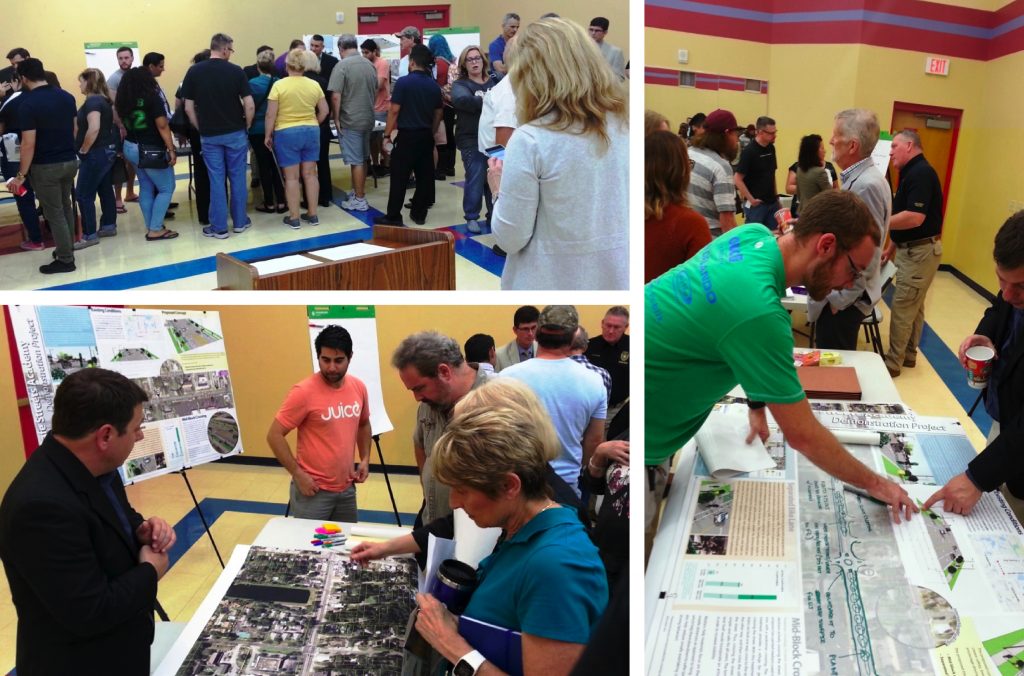
Business owners, community members, and elected officials attended a community meeting to learn more about the demonstration project on Curry Ford Road and share their thoughts on problems and solutions for the street.
Because dangerous streets like Curry Ford Road are widespread throughout the Orlando region, the team knows that to eliminate traffic deaths in the long term, they will need to collaborate with local and regional agencies. They decided to use their demonstration project as an opportunity to strengthen partnerships with local and regional elected leaders and with regional agencies, including Orange County, to improve cooperation on safety projects moving forward. They held a hearing with their city council, scheduled three meetings with local commissioners to brief them about the project, and participated in biweekly coordinating meetings with Orange County, who has jurisdiction over a portion of Curry Ford Road included in the project. They also worked with Lynx, the local public transit agency, to evaluate how the project would impact bus stops along the street.
“What we have is a regional issue, and we need to work together for consistency and for greater audience. were actually really good partners with safety, and I see that only expanding to other counties and to metropolitan planning organizations.”
–Christopher Cairns, City of Orlando
Creating a slower, safer street
The Orlando team used their demonstration project to transform Curry Ford Road into a safer place for people walking, biking, and driving. In just five years, cars struck 16 people biking and eight people walking along a 1.6 mile stretch of Curry Ford Road. The team focused their demonstration project on a half-mile segment of the street between Bumby Avenue and Crystal Lake Drive where the street has five lanes wide with narrow sidewalks, no amenities for people biking, and very few marked places to cross the street. In Florida, drivers are legally required to yield to people crossing the street at any intersection, but they seldom do if crosswalks aren’t marked, as in the case of much of Curry Ford Road.

Orlando’s analysis of Curry Ford Road revealed hotspots of crashes involving people walking and biking. The analysis also showed that speeding is a common problem on Curry Ford Road by comparing the posted speed limits to the 85th percentile speed, or the speed that 85 percent of people drive at or below. Finally, the Orlando team also measured the volume of cars on the road, or the Average Annual Daily Traffic (AADT) on both weekdays and weekends to show that the street did not warrant four to five lanes for cars.
“What we’ve done in the past is not working, so you need to try different things. It’s not all about moving cars or being convenient for commuters. It’s balancing everybody.”
–Christopher Cairns, City of Orlando
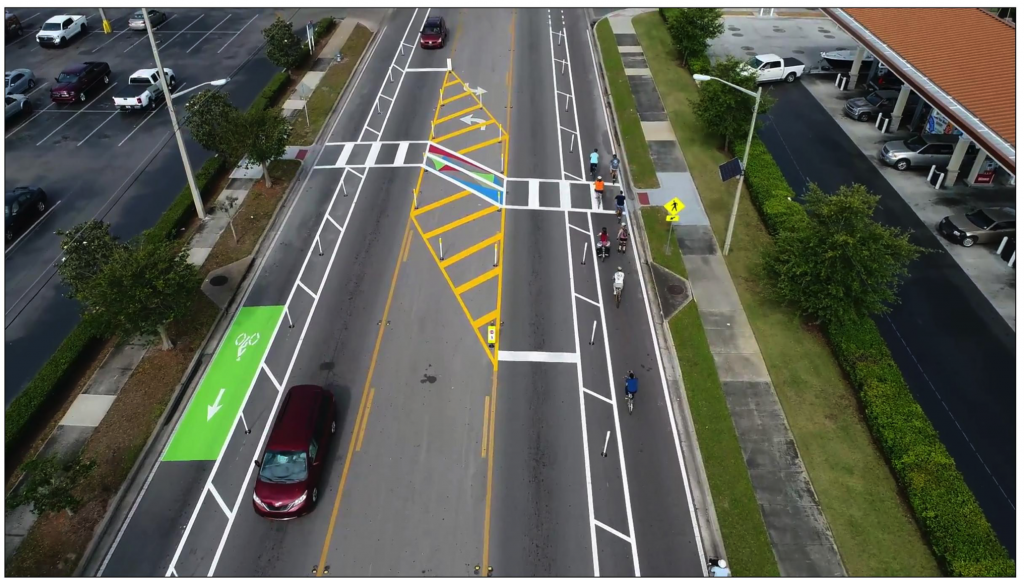
Overhead shot of Orlando’s demonstration project Curry Ford Road.
The Orlando team decided to implement a road diet on Curry Ford Road by reducing the number of lanes from five to three and replacing the outside travel lanes with protected cycle tracks. They also added a mid-block crossing at the main entrance to the streets’ strip mall using paint, tape, vertical posts, and signage. They also used green paint to mark conflict zones where the cycle track shared space with bus stops.
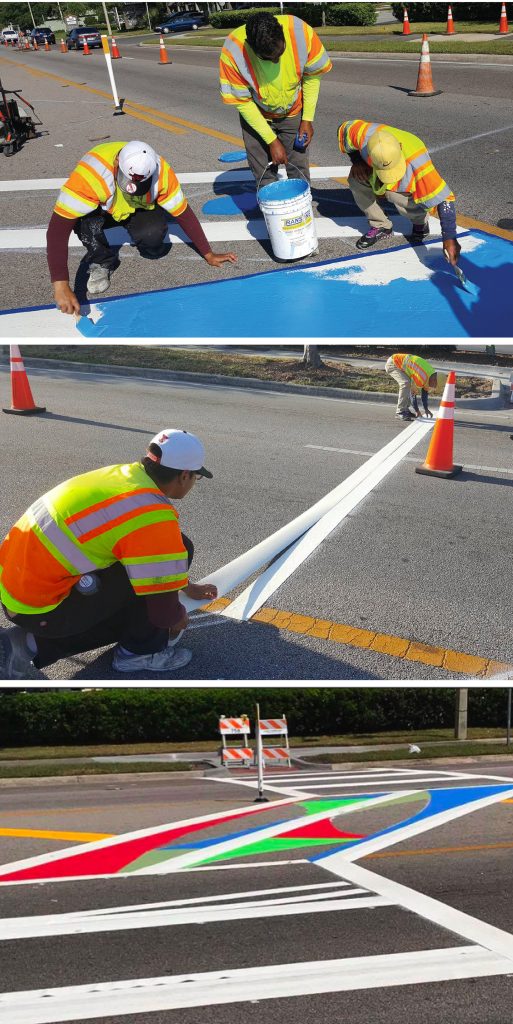
Workers used paint and tape to install a new mid-block crossing on Curry Ford Road.
Proven safety countermeasures
The Federal Highway Administration (FHWA) promotes specific road treatments, proven through research to reduce crashes, injuries, and fatalities on our streets. Orlando’s demonstration project used the following proven safety countermeasures recommended by the FHWA:
![]()
Road diet
19-47 percent fewer crashes
Orlando’s demonstration project slowed down traffic by reducing the number of travel lanes and replacing the reclaimed space with a protected cycle track.
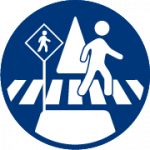
Pedestrian crossing island
56 percent fewer pedestrian crashes
Orlando’s demonstration project also introduced a new mid-block crosswalk with a painted pedestrian refuge to make it easier and safer to cross the street.
To introduce the community to the new and improved Curry Ford Road, Orlando hosted a community safety fair. Local business owners set up stalls with giveaways and the city ran drills on biking safety skills with free helmet fittings. The event helped the community learn more about the project and local amenities on Curry Ford Road. Nearby residents in particular were enthusiastic about the changes and felt much more comfortable walking and biking along the street.
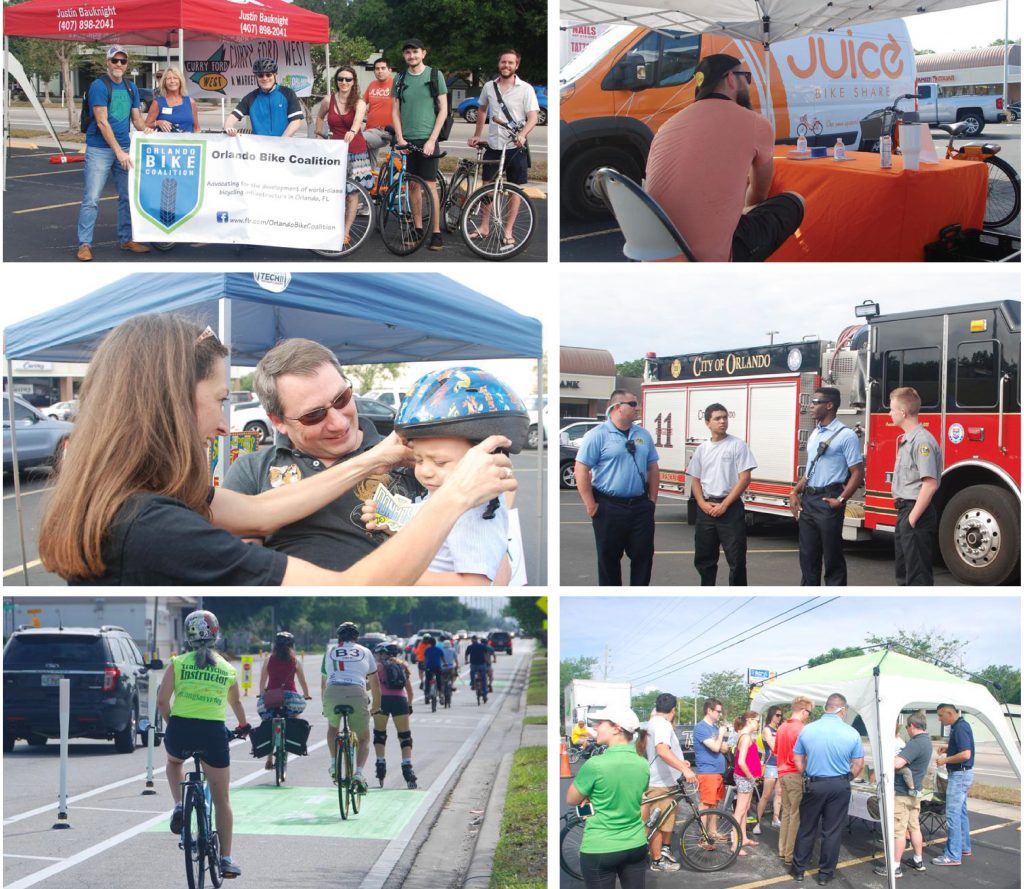
Assorted photos from Orlando’s community safety fair on Curry Ford Road.
“I am extremely happy that Orlando is willing to test out these types of programs so that we can learn better ways to incorporate alternative transportation into our city. As Orlando continues to grow, these alternatives will become necessary to make the city safer and more accessible for everyone. Orlando is already one of the worst cities in the country for pedestrian safety, and simply adding more roads and cars is not the solution to our problem … During this 30-day test I only ever experienced congestion during the 1-2 hours of peak traffic each day, and I was never personally delayed for more than a few minutes. I find this to be a minor inconvenience when considering the increased safety it provides for the remaining days/hours of the week.”
-Todd Schenck, Conway/Orlando Resident since 2003
Unfortunately, many people disagreed with the changes on Curry Ford Road. In particular, people who expect to travel at a high speed through the neighborhood were resistant to the project. They called and emailed the city with negative feedback, primarily to complain about the added travel time and congestion the project created. In the first two weeks of the demonstration, the Orlando team received 142 emails, of which 39 percent were in favor of the project and 61 percent were opposed. This backlash started important conversations between city staff and the community about the trade-offs between speed and safety, especially on arterial roads that have to balance moving cars with moving people safely and comfortably. Some of the naysayers who spoke with city staff ultimately conceded that safety was important and that the delays were a necessary inconvenience. However, others thought that the project was unnecessary because “only” so many people died on Curry Ford Road in traffic crashes in recent years, despite the fact that the only acceptable number of deaths on our roadways should be zero.
“Do you want to be a drive to or a drive through community? If you want to be a drive to, there’s going to be a trade-off. You can’t have both.”
–Cade Braud, City of Orlando
Despite the backlash the project received, the transformation of Curry Ford Road successfully slowed down travel speeds to create a safer, more comfortable place for people walking, biking, and shopping. Cars yielded correctly to people walking at the new mid-block crossing, and although travel times increased by up to five or six minutes during rush hour, during most other times and days, travel times for cars did not increase significantly. The project also improved the working relationship between the city and the county who were able to coordinate effectively on a shared safety project in a very rapid timeline. Although the city removed the project at the end of the one-month demonstration, the team hopes to continue negotiations with Orange County for permanent safety improvements on Curry Ford Road.
Lessons learned
Based on Orlando’s experience transforming Curry Ford, communities around the country can learn from the following lessons to launch their own safety demonstration projects:
1. Collaboration across jurisdictions is important—and possible.
Creating safer, Complete Streets on state and county roads can sometimes be a challenge, but the Orlando team was able to collaborate successfully with Orange County on their demonstration project despite working on an accelerated timeline. Their experiences demonstrate that working together on safety projects is not only possible, it is also necessary to address persistent safety issues that impact people at a regional scale. This demonstration project will make it easier for Orlando and Orange County to collaborate on safety on this and other projects moving forward.
2. You need thorough community engagement to build support for projects that improve safety, especially when these projects come with trade-offs for driving speed.
Orlando’s project faced significant resistance, especially from people who care more about their speed than others’ safety. To create a culture of safety moving forward and make it easier to implement future projects, Orlando—and communities like it around the country—will need to engage and educate the community earlier and more often in project planning processes, explaining upfront the difficult but necessary trade-offs these projects will face. They’ll also need to work harder to engage not only local business owners and residents who move along and across the street, but also the people who regularly pass through the street about the importance of safety over speed.
—
The Safe Streets Academy is funded by Road to Zero, a coalition of almost 700 organizations committed to reducing traffic fatalities in the United States to zero over the next three decades. To learn more about this demonstration project and similar projects in Lexington and South Bend, read the full report here.
Related News

© 2025 Smart Growth America. All rights reserved
Site By3Lane Marketing














